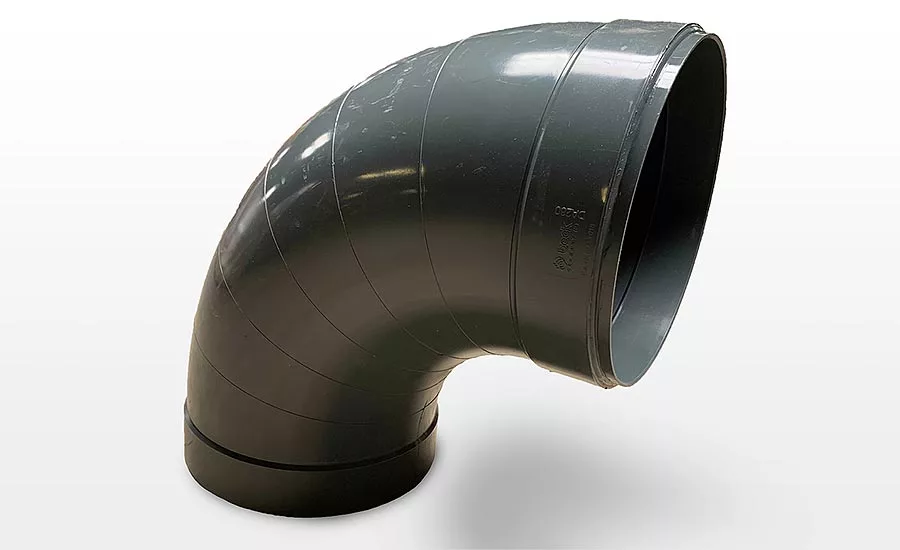Guest Editorial: When to use PVC duct for your project
The benefits and limitations of PVC ductwork.

PVC, or polyvinyl chloride, is a durable material used in a variety of construction projects. It’s lightweight and easy to transport, making it the preferred material for many contractors. PVC duct, however, does have some limitations and cannot be used in certain applications. Read on to learn more about the uses of PVC duct.
Benefits of using PVC duct
PVC itself has many benefits, and it’s become the go-to choice for many contractors for a variety of reasons. One of the most substantial benefits of using PVC duct is that it is resistant to corrosion. Unlike metal ductwork, which can rust and corrode over time, PVC duct can stand up to gases, fumes and exhaust. This resistance will help home and business owners have fewer issues in the future. In fact, PVC duct is generally long-lasting and requires few repairs over the course of its lifespan.
Another benefit of PVC duct is its lightweight construction. This makes the duct easy to transport and install in a variety of locations, including floors, walls and ceilings. It can even be installed within concrete slab foundations, where metal duct could not withstand the moisture. PVC can bend and flex as well, allowing it to handle heavier loads in slab or underground. In addition, PVC is a much better insulator than its metal counterpart, which can disperse hot and cold air rather than maintain its temperature. PVC fittings create a strong seal as well, blocking potentially harmful gases from making their way into homes and businesses.
PVC duct limitations
While PVC duct is an effective heat insulator, it does have some temperature limitations. For applications where temperatures may exceed 140° F, other materials should be considered. CPVC, for example, offers many of the same benefits of PVC, including its lightweight construction and corrosion resistance, but CPVC can transport liquids and gases with temperatures up to 200°.
Ductwork made of PVC is certainly lightweight, but in some cases, it can weigh up to twice as much as metal duct. This may prove challenging in certain overhead configurations, where more support is needed. In addition, custom metal ductwork is often more easily accessible than PVC, making metal a preferred choice when portions of a system need replacement. However, it’s important to note that metal and PVC duct are not interchangeable or inter-connective. When exhaust repairs are needed, ductwork will need to be replaced using the same material that is found in the existing system.
Best applications
In general, standard PVC piping is widely known for its versatility, with uses in basic plumbing, pool installations and more. The thin walls and resistance to corrosion of PVC duct, however, make it the perfect choice for residential and commercial exhaust systems. The duct transports easily and installation is simple. Cuts and fittings can all be done onsite, as well, which allows for completely customizable systems that will match the unique needs of any home or business owner. In addition, the chemically resistant properties of PVC allow it to safely transport toxic gases and fumes away from buildings safely, without the concern for corrosion that can come with metal ductwork.
PVC duct isn’t only used in construction. It’s recently become a popular material for creating lightweight structures around the home. Because it’s easy to cut, more pliable than metal piping, and comes with a variety of fitting options, many do-it-yourselfers have found a variety of uses for PVC duct, including poolside towel racks, dog jumps, clothing racks and more. Customization and construction are simple, and the possibilities are endless!
When to consider using another material
PVC duct has thinner walls than standard piping. While this helps to keep the weight down, it also restricts its functionality. PVC duct cannot withstand the transportation of pressurized liquids and is not suitable for plumbing projects. In addition, the heat limitations of PVC duct, which can withstand temperatures up to 140°, may not be best suited for HVAC systems that are likely to transport extremely hot air on a frequent basis. If used in these systems, PVC may become more brittle, creating breaks and cracks along the line. CPVC is a great alternative because, unlike metal, it is resistant to chemicals and corrosion, though it meets a higher temperature limit.
Using PVC duct in exhaust systems
When configuring a new exhaust system, consider using PVC duct. Because it’s lightweight and durable, it is easy to install and customize according to your needs. It’s also resistant to corrosion, making it the perfect material for transporting harmful gases and fumes. Unfortunately, due to its temperature limitations, PVC duct may not be the right material for HVAC systems, and it’s not designed to withstand pressurized liquids. In these applications, select a different material such as CPVC or metal. However, PVC ductwork has a long lifespan, which will cut down on repairs and maintain a strong exhaust system for years to come.
Looking for a reprint of this article?
From high-res PDFs to custom plaques, order your copy today!








